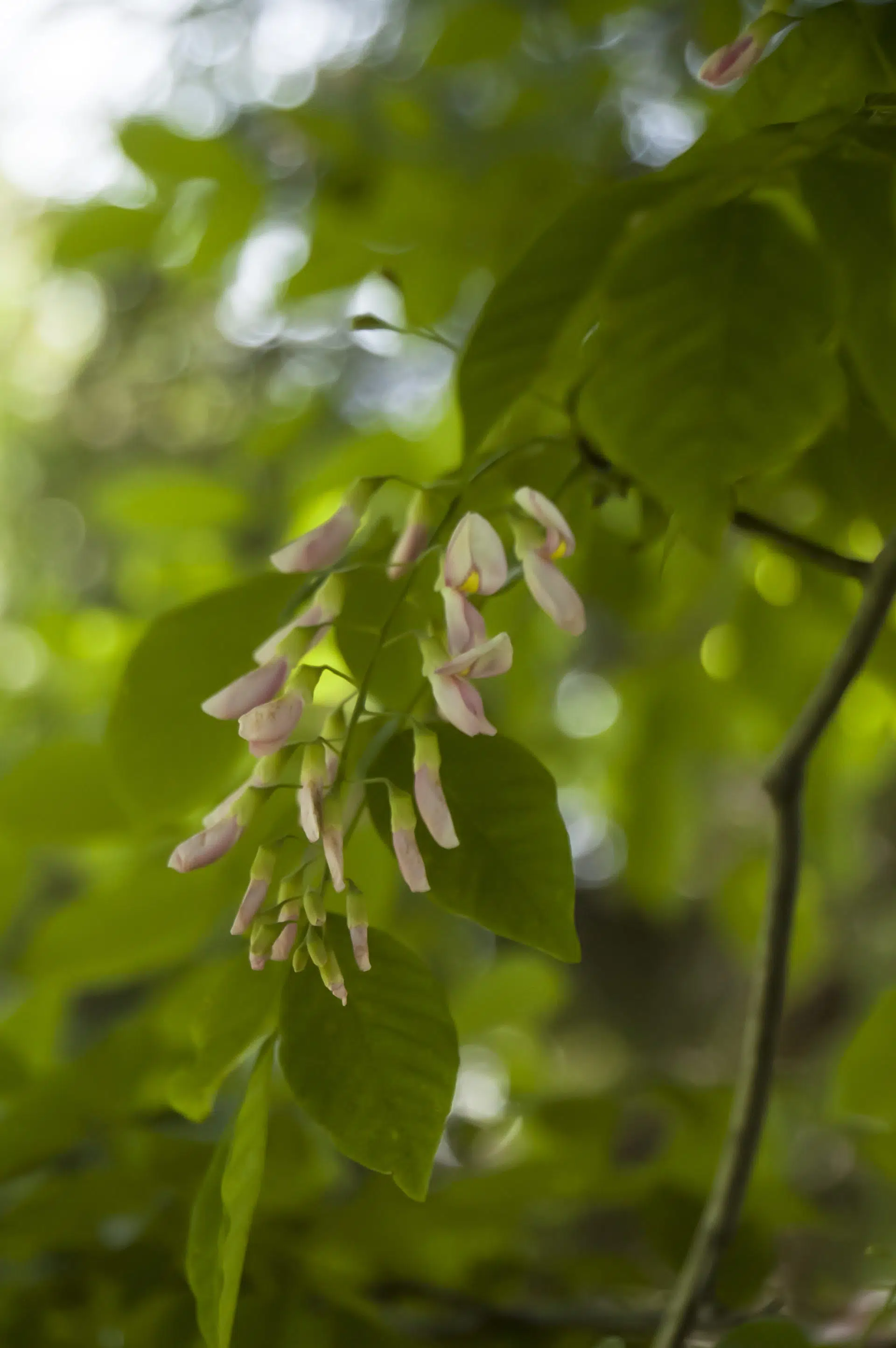Nature Profile
Trees
American yellowwood
Cladrastis kentukea

American yellowwood
Cladrastis (klad-RAS-tis) kentukea is a very uncommon yet beautiful tree first discovered in the Cumberland region of Tennessee by French botanist André Michaux in 1796. It may still be found growing naturally on limestone bluffs, on slopes, ridges, in river valleys and along streams in Alabama, Mississippi, Missouri, Arkansas, Tennessee and Illinois as well as southern Indiana, eastern Oklahoma, western North Carolina and northern Georgia. Belonging to the Leguminosae (pea family), there are six species of Cladrastis, all native to China and Japan except for Cladrastis kentukea.
In late September through mid-October at The Holden Arboretum the foliage of yellowwood turns an attractive shade of yellow. The stalks of the compound leaves (rachis) persist for a while after the leaves drop. New leaves break bud early in spring with the earliest recorded date at the Arboretum being March 29 in 2012. This makes them susceptible to late spring frosts. Although the tree will regrow a full complement of leaves within a few weeks, these events deplete the precious stored starches necessary for reproduction.
The white flowers, borne in drooping panicles, are very showy for about a week every two to four years. In the “off” years bloom is either non-existent or sparse in comparison to a “banner” year. Their fragrance is mild during the day but more pervasive at night. The first blooms typically open between the last week of May and the first week of June and last for about two weeks. Two 14-year-old trees grown from seed in Jessamine County, Kentucky, and planted in our Specimen Tree Collection have yet to flower.
When the tree reaches maturity – about 20 years from seed or two to four years for grafts – the fairly inconspicuous pods containing hard seeds rarely result in seedlings in the garden. After the leaves have started to fall, the thin 3-4” long brown pods open but some are held into winter. The bark of yellowwood resembles American beech, being light gray and relatively smooth. Its common name refers to the yellow color of the heartwood when freshly cut, turning brown when dried. Frost cracks in the thin bark can disfigure the handsome trunk of yellowwood and allow fungal pathogens to enter, so it is advisable to protect the main stem with tree wrap during winter while the tree is young. Improper pruning can also mar the beauty of this tree. Never prune in winter or spring as sap will “bleed” from the cut and congeal in a most unattractive manner. The best time to prune is July, and the smaller the branch or branchlet cut, the better. When branches larger around than one’s wrist are cut, the wound cannot properly compartmentalize, leading to rot or cavities to form in the trunk. The use of tree wound paint is not recommended as it has been demonstrated to provide a moist environment beneath that is conducive for the establishment of fungi.
At the Arboretum, the growth rate of young (30 year) yellowwood has been a foot to 15 inches a year on the most favorable sites. In the Specimen Tree Collection is a yellowwood originally received as a 10” seedling in 1958 that measured 30’ tall in 1985 and 54’ tall, 56’ wide, 26” trunk diameter in 2014. It has a fissure in its trunk where rot has set in, and is low-branched like most yellowwood. At the David G. Leach Research Station in Madison is a specimen that was 4’ tall when received on July 28, 1986. This yellowwood has grown in a modest opening between black locust (Robinia pseudoacacia) trees. The soil it is growing in is a sandy loam. In 2006 it measured 29’ tall by 24’ wide, and in 2011 was 40’ x 25’.
Cladrastis kentukea ‘Perkin’s Pink’, in the moist soil east of Lotus Pond has new flowers that are blush pink. ‘Perkin’s Pink’ was propagated from a tree growing at the Perkins School for the blind in Watertown, Massachusetts, and distributed to the Arnold Arboretum as well as to Brimfield Nurseries in Connecticut over 50 years ago. Our specimen was planted on May 8, 1997 in a silt loam and has grown to 26’ tall by 27’ wide as of June 2015. Its fall foliage is the same yellow as the species, although in one year, 2007, it did not turn color until November. This phenomenon occurs with other trees as well. For example, a red maple, Acer rubrum ‘October Glory’, turns color a month earlier in the relatively dry soil along the Corning Visitor Center exit drive than does its identical twin growing in the moist soil of the Arborvitae Collection along Sperry Road.
The Society of Municipal Arborists (worldwide) selected the yellowwood (Cladastris kentukea) as its Urban Tree of the Year for 2015. This annual selection must be adaptable to harsh growing conditions, be underutilized and have ornamental appeal. Yellowwood does indeed fit all the criteria above, and can grow in high pH (up to 8.2) as well as low pH soils (to 4.5). However, it is not at all adapted to waterlogged or poorly drained soils.
The general rule is “the smaller the better” for long-term success when choosing a tree to plant. Yellowwood transplants quite readily in sizes up to 2-inch caliper. Once established, the tree is fairly tolerant of drought. Its deep-rooted nature is accommodating to companion plantings. A weeping form, ‘White Rain’ has also been selected and may be available in coming years.




